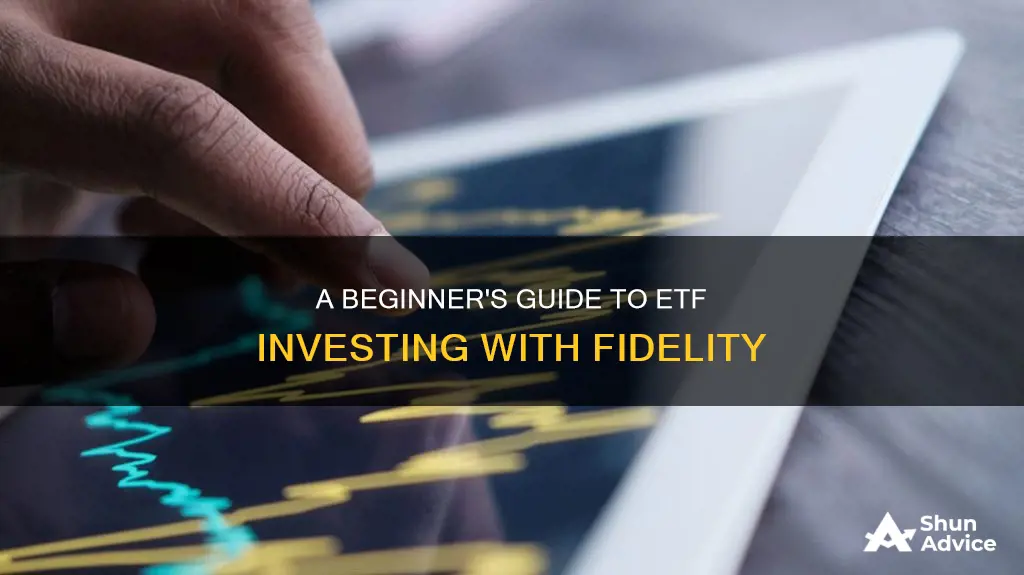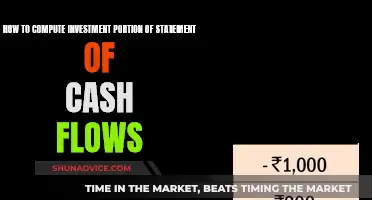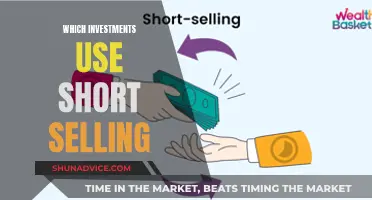
Exchange-traded funds (ETFs) are a popular investment vehicle that offers several benefits, including diversification, ease of trading, and low costs. When investing in ETFs using Fidelity, there are a few key steps to follow. Firstly, it is essential to understand the different types of ETFs available, such as active equity, fixed income, thematic, and sustainable ETFs. Fidelity offers a wide range of ETFs to choose from, including their Enhanced Large Cap Core ETF, Total Bond ETF, and Wise Origin Bitcoin Fund.
Once you have decided on the type of ETF that aligns with your investment goals, you can use Fidelity's ETF Screener tool to identify specific ETFs that match your criteria. This tool allows you to compare various ETFs based on factors such as costs, dividends, taxes, and liquidity. After selecting the ETF you wish to invest in, you can follow Fidelity's simple six-step process to place a trade: select the account, enter the trading symbol, choose between buying or selling, specify the amount in dollars or shares, select the order type, and decide on the order duration. It is important to consider the different order types, such as market orders and limit orders, as they can impact the execution price and timing of your trade.
By following these steps and utilizing the tools provided by Fidelity, investors can effectively navigate the process of investing in ETFs and make informed decisions that align with their financial objectives.
| Characteristics | Values |
|---|---|
| Investment options | Active, thematic, sustainable, stock, sector, factor, and bond ETFs |
| Investment strategies | Active and passive exchange-traded funds, research tools, and expertise |
| Costs | Activity assessment fee (from $0.01 to $0.03 per $1,000 of principal) |
| Trading flexibility | Competitive pricing |
| Tax | Tax-efficient |
| Trading steps | 1. Select the account you want to trade in. 2. Enter the trading symbol. 3. Select Buy or Sell. 4. Choose between Dollars and Shares, then enter an amount. 5. Choose an order type: Market or Limit. 6. For limit orders, decide how long the order will stay open. Day or Good 'til Canceled (GTC). |
What You'll Learn

Fidelity's ETF research tools and resources
Fidelity offers a range of tools and resources to help investors make informed decisions about ETFs. Here are some of the key features:
- ETF Screener: This powerful tool allows investors to search and compare different ETFs based on their investment goals. Investors can access unique data and search capabilities to identify ETFs and ETPs that match their specific objectives.
- Portfolio Builder: This feature helps investors create a diversified ETF portfolio tailored to their risk tolerance. It provides a personalized approach to investing, ensuring that investment choices align with the investor's comfort level and financial goals.
- Market Insights and Sector Filtering: Fidelity provides access to market insights and sector-specific information. Investors can filter ETFs by sectors, research and compare different options, and make informed decisions based on their investment strategies.
- Virtual Assistant: Fidelity's automated natural language search engine assists investors in navigating the Fidelity website. It helps users find relevant information about ETFs, although it is important to review the results carefully and make investment decisions based on individual research.
- Educational Resources: Fidelity offers a comprehensive Learning Center with educational content on various investment topics, including ETFs. Investors can access articles, guides, and videos to enhance their understanding of ETFs, their benefits, risks, and how they work.
- Fidelity Viewpoints: Subscribers receive timely news and insights from Fidelity professionals on markets, investing, and personal finance. This resource helps investors stay informed about market trends and make more strategic decisions.
- ETF Trading Tips: Fidelity's ETF Management & Strategy Team provides valuable tips for buying and selling ETFs, helping investors make smarter trading decisions by considering important costs and factors.
- Actively Managed ETFs: Fidelity offers actively managed ETFs that aim to seek better investing outcomes. These ETFs provide trading flexibility and potential tax efficiency, allowing investors to benefit from Fidelity's expertise and research.
Unlocking the Power of Idle Cash: Smart Investment Strategies
You may want to see also

Understanding the differences between ETFs and mutual funds
Exchange-traded funds (ETFs) and mutual funds are both popular investment options for those looking to diversify their portfolios. While they share some similarities, there are some key differences to be aware of when deciding which is right for you.
Both ETFs and mutual funds are professionally managed collections or "baskets" of individual stocks or bonds. They are both less risky than investing in individual stocks and bonds due to their built-in diversification. They also both offer a wide variety of investment options, overseen by professional portfolio managers, and can be purchased commission-free.
The main difference between the two is that ETFs can be traded throughout the day like ordinary stocks, whereas mutual funds can only be sold once a day after the market closes. ETFs are also more suitable if you prefer lower investment minimums, as they can be bought for the price of a single share, whereas mutual funds usually have a flat-dollar minimum investment of hundreds or thousands of dollars. ETFs provide real-time pricing and allow for more sophisticated order types, giving you more control over the price of your trade. Additionally, ETFs are usually passively managed, tracking a market index or sector sub-index, while mutual funds are typically actively managed, with fund managers making decisions about how to allocate assets. Actively managed funds tend to have higher fees and expense ratios due to their higher operations and trading costs.
ETFs are also typically more tax-efficient than mutual funds. The process of creating and redeeming shares of a mutual fund can trigger capital gains tax liabilities for all shareholders, whereas this is less likely for ETF shareholders who are not trading shares.
How Cash Investments Impact Owners' Equity
You may want to see also

How to choose an ETF
With thousands of ETFs available, it can be challenging to narrow down your options. Here are some key factors to consider when choosing an ETF:
- Role in Your Portfolio: Understand the role you want the ETF to play in your broader portfolio. Are you looking for a foundational building block or specific exposures to fill gaps? Knowing what you want to achieve will help you select the right ETF.
- Active or Passive: There are two main types of investing strategies: active and passive. Active ETFs are managed by professionals aiming to beat the performance of an index, while passive ETFs (index ETFs) aim to track the performance of an index minus any fees. Some investors prefer one strategy over the other, while others use a mix of both.
- Underlying Investments: Understand what the ETF owns and how it gains exposure to the underlying investments. For example, some ETFs may hold physical commodities like gold or silver, while others use derivatives.
- Performance: While past performance is not a guarantee of future results, it can be helpful to compare an ETF's performance to its benchmark to see how well it has achieved its goals.
- Expense Ratio: The expense ratio represents the annual cost of investing in the ETF as a percentage of assets managed. This is an essential factor in evaluating the cost of investing in a given ETF.
- Issuer/Sponsor: The issuer or sponsor is the company that offers and manages the ETF. Some investors prefer established providers with strong reputations and long track records, especially for core portfolio holdings.
- Ratings: Many ETFs receive ratings from independent firms that analyse their performance. These ratings can provide insights into how well an ETF is managed regarding cost, efficiency, and other factors compared to its peers.
- Asset Class and Objective: Understand the ETF's asset class and investment objective by checking its benchmark and exposures. This information can usually be found in the ETF's fact sheet or prospectus on the fund sponsor's website.
- Level of Assets: Look for ETFs with a minimum level of assets, as those below a certain threshold may have limited investor interest, poor liquidity, and wide spreads. A common threshold is at least $10 million in assets.
- Trading Activity: Trading volume is an indicator of liquidity. Generally, ETFs with higher trading volumes are more liquid and have tighter bid-ask spreads.
- Underlying Index or Asset: Consider the underlying index or asset class the ETF is based on. For diversification, it may be preferable to choose an ETF based on a broad, widely followed index.
- Tracking Error: Most ETFs track their underlying indexes closely, but some may have a greater degree of tracking error. It is generally preferable to choose an ETF with minimal tracking error.
- Market Position: The first ETF issuer for a particular sector often captures the most significant share of assets. Avoid ETFs that are imitations of an original idea.
GDP and Investments: What's the Real Relationship?
You may want to see also

Understanding ETF liquidity
Liquidity is one of the most important features of an exchange-traded fund (ETF) and a major draw for investors. It refers to how easily shares can be bought and sold without significantly impacting the ETF's market price. A highly liquid ETF allows for swift transactions at prices that closely reflect the intrinsic value of the underlying assets. This ensures that investors can enter or exit positions without encountering substantial price discrepancies or high trading costs.
Primary and Secondary Markets
The concept of liquidity in ETFs involves a multitiered framework, including the dealer and secondary markets.
Primary Market
In the primary market, or dealer market, liquidity is facilitated through the creation and redemption mechanisms. This unique process allows for the adjustment of an ETF's supply to meet investor demand, maintaining price stability. ETFs rely on a distinct creation and redemption mechanism that provides primary market liquidity. Authorized Participants (APs) can create or redeem ETFs and exchange the "baskets" of the ETF's underlying securities for new ETF shares from the fund issuer.
Many ETFs are open-ended funds, meaning they can continuously adjust the number of outstanding shares based on demand and supply dynamics. The creation and redemption of ETF shares in the primary market may result in transactions in the underlying security markets.
Secondary Market
The secondary market is where most investors trade, buying and selling ETF shares on exchanges, much like individual stocks. This market is also referred to as the stock market. The liquidity in the secondary market is described through the trading volume of the underlying securities in the ETF and their bid-ask spread. A narrower spread often indicates higher liquidity and lower trading costs.
Indicators of Liquidity
There are two primary indicators of liquidity:
- Trading Volume: Higher trading volume often correlates with greater liquidity as more buyers and sellers in the market mean transactions can be completed more easily.
- Bid-Ask Spread: This is the difference between the highest price a buyer is willing to pay (the bid) and the lowest price a seller is willing to accept (the ask or offer). A narrower bid-ask spread usually signifies higher liquidity.
Factors Affecting Liquidity
An ETF's liquidity is influenced by a combination of factors, including:
- The liquidity of the underlying securities it holds
- The trading volume of the securities it holds
- The trading volume of the ETF itself
- The investment environment
Misconceptions About ETF Liquidity
It is important to note that high trading volume does not always equate to high liquidity. Even ETFs with lower trading volumes can exhibit good liquidity due to the creation and redemption mechanisms. Additionally, the size of an ETF, measured by its assets under management (AUM), does not necessarily dictate its liquidity. ETFs with smaller AUM can have high liquidity if they track a liquid index or sector and have active APs facilitating the creation and redemption process.
Importance of ETF Liquidity
Liquidity is crucial for investors and traders as it allows for the quick and efficient conversion of assets into cash. Investors holding illiquid ETFs may face challenges when attempting to sell, potentially missing out on their desired price or time frame.
Understanding the dynamics of ETF liquidity, including the roles of various market players, is essential for investors to make informed decisions and improve their investment results.
Investment Strategies: Cash Flow-Agnostic Criteria
You may want to see also

How to trade ETFs
Trading ETFs with Fidelity is a simple process, but it's important to do your research first.
Firstly, you'll want to find the right ETF for you. Use the screener to identify ETFs and ETPs that match your investment goals. You can access unique data and search capabilities to help you find the right ETF. You can also learn about the various tools and resources that Fidelity offers for ETFs.
Once you've found the right ETF, you can follow these steps to place a trade:
- Select the account you want to trade in.
- Enter the trading symbol.
- Select 'Buy' or 'Sell'.
- Choose between 'Dollars' or 'Shares', then enter an amount.
- Choose an order type: 'Market' or 'Limit'. Use the definitions provided to help make your choice.
- For 'Limit' orders, decide how long the order will stay open: 'Day' or 'Good 'til Canceled' (GTC). Again, use the definitions to help guide your choice.
After you've entered these details, preview your order. If everything looks good, click 'Place Order' and you're done!
Investment Casting: Art of Molding Liquid Metals
You may want to see also







